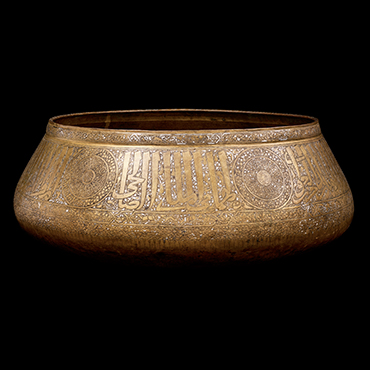Royal generosity
Inscriptions:
Around the body, in thuluth:
The high authority, the lordly, the possessor, the great amir, the learned, the diligent, the holy warrior, the champion of the faith, the defender, the protector of frontiers, the assisted (by Allah), the treasure, the aid, the valiant, the affiliated with al-Malik al-Salih.
In the radiating inscriptions in the roundels, in thuluth, variations on the following phrase:
The noble authority, the high, the lordly, the possessor, the learned, the diligent.
This bowl, in one of the most frequently encountered forms from the Mamluk period, is by far the largest example known. The quality of the workmanship is also remarkable; bold calligraphy glorifying the ruler features alongside intricate engravings of silver animals, flowers, and scrolls, originally highlighted in gold.
This bowl was created for the court of one of the sons of the powerful Mamluk sultan al-Nasir Muhammad bin Qala‘un (r. AH 693–741/1293–1341 CE, with interruptions). Two of his sons adopted the regnal title of al-Salih, which is inscribed on this bowl: Isma‘il (r. AH 743–46/1342–45 CE) and Salih (r. AH 752–55/1351–54 CE). The period following their father’s death was marked by significant political instability, as various factions of nobles vied for control over the state, backing their preferred candidates for the throne. Within a span of 13 years, there were nine different sultans, all brothers. This political insecurity likely prompted many sultans and nobles to commission extraordinary works of art to assert their power. The last of the brothers was Sultan Hasan who commissioned the ultimate example of this extravagance. He oversaw the construction of a grand and beautifully furnished mosque below the citadel in Cairo. He is reported to have said he would have abandoned the whole scheme but for the shame it would bring if people could say that an Egyptian sultan was not able to complete a mosque he had started.[1][2]
This bowl was undoubtedly designed to impress. It stands out as the only recorded large inlaid Mamluk vessel from an earlier period that features lightly gilded brass. This technique enhances the richness of the base material, creating a striking contrast with the black composition ground, while not detracting from the gleaming precious silver and gold inlays.
Royally generosity
Bowl
Egypt or Syria, AH 743–46/1342–45 CE or AH 752–55/1351–54 CE
Brass, hammered, gilded; silver, gold and black composition inlaid and engraved, h. 31.9 × w. 77.7 × d. 77.7 cm
Furusiyya Art Foundation, R-2073

